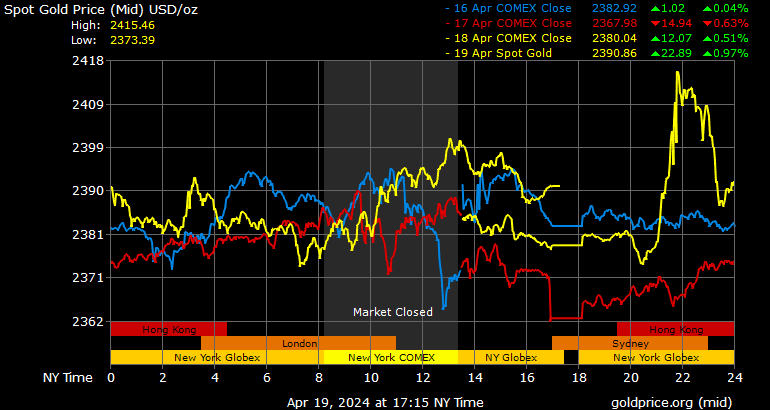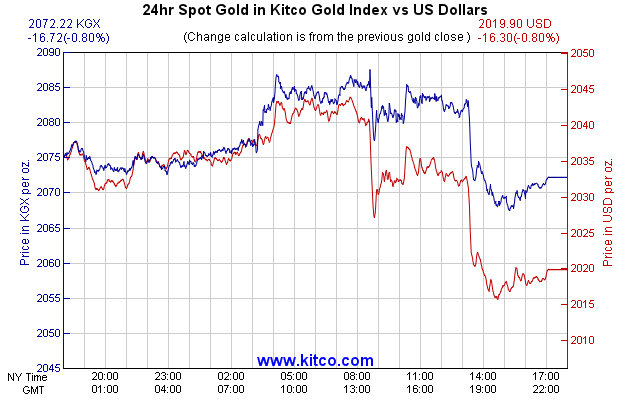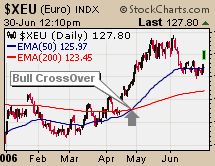By Jim Wyckoff
Of Kitco News www.kitco.com | |
One of the more popular computer-generated technical indicators is the Relative Strength Index (RSI) oscillator. (An oscillator, defined in market terms, is a technical study that attempts to measure market price momentum—such as a market being overbought or oversold.)
I’ll define and briefly discuss the RSI, and then I’ll tell you how I use it in my market analysis and trading decisions.
The Relative Strength Index (RSI ) is a J. Welles Wilder, Jr. trading tool. The main purpose of the study is to measure the market's strength or weakness. A high RSI, above 70, suggests an overbought or weakening bull market. Conversely, a low RSI, below 30, implies an oversold market or dying bear market. While you can use the RSI as an overbought and oversold indicator, it works best when a failure swing occurs between the RSI and market prices. For example, the market makes new highs after a bull market setback, but the RSI fails to exceed its previous highs.
Another use of the RSI is divergence. Market prices continue to move higher/lower while the RSI fails to move higher/lower during the same time period. Divergence may occur in a few trading intervals, but true divergence usually requires a lengthy time frame, perhaps as much as 20 to 60 trading intervals.
Selling when the RSI is above 70 or buying when the RSI is below 30 can be an expensive trading system. A move to those levels is a signal that market conditions are ripe for a market top or bottom. But it does not, in itself, indicate a top or a bottom. A failure swing or divergence accompanies the best trading signals.
The RSI exhibits chart formations as well. Common bar chart formations readily appear on the RSI study. They are trendlines, head and shoulders, and double tops and bottoms. In addition, the study can highlight support and resistance zones.
How I employ the RSI
As you just read above, some traders use these oscillators to generate buy and sell signals in markets-—and even as an overall trading system. However, I treat the RSI as just one trading tool in my trading toolbox. I use it in certain situations, but only as a “secondary” tool. I tend to use most computer-generated technical indicators as secondary tools when I am analyzing a market or considering a trade. My “primary” trading tools include chart patterns, fundamental analysis and trend lines.
Oscillators tend not to work well in markets that are in a strong trend. They can show a market at either an overbought or oversold reading, while the market continues to trend strongly. Another example of oscillators not working well is when a market trades into the upper boundary of a congestion area on the chart and then breaks out on the upside of the congestion area. At that point, it’s likely that an oscillator such as the RSI would show the market as being overbought and possibly generate a sell signal—when in fact, the market is just beginning to show its real upside power.
I do look at oscillators when a market has been in a decent trend for a period of time, but not an overly strong trend. I can pretty much tell by looking at a bar chart if a market is “extended” (overbought or oversold), but will employ the RSI to confirm my thinking. I also like to look at the oscillators when a market has been in a longer-term downtrend. If the readings are extreme-—say a reading of 10 or below on the RSI-—that is a good signal the market is well oversold and could be due for at least an upside correction. However, I still would not use an oscillator, under this circumstance, to enter a long-side trade in straight futures, as that would be trying to bottom-pick.
Oscillators are not perfect and are certainly not the “Holy Grail” that some traders continually seek. However, the RSI is a useful tool to employ under certain market conditions.
|


LISTENING TO: IKIMfm
IKIMfm
Pilihan Utama Anda
Live Online Trends
Tuesday, April 17, 2018
Sharpening Your Trading Skills: The Relative Strength Index (RSI)
Monday, April 16, 2018
What is leverage?
Leverage is a facility that enables you to gain a large exposure to a financial market while only tying up a relatively small amount of your capital. It is a key feature of CFD trading.
When you invest in a leveraged product, the provider will ask you to put up a sum representing just a fraction of the total value of your position. Effectively, the provider is lending you the balance.
Your profit or loss is based on the full position, however. So the amount you gain or lose might seem very high in relation to the sum you’ve invested. It could even be much greater than your initial outlay.
To find out more about how leverage is a key component of CFD trading, please visit the Leverage and Margin section of our CFD trading module.
Your initial outlay is referred to as a margin or deposit requirement. Your provider will request this to cover or part-cover any potential losses you may incur.
The margin is always a fraction of what it would cost to buy the assets directly, but the exact size depends on various factors – a more liquid and less volatile market will require a smaller margin (e.g. 5%), whereas a volatile market may require a larger margin.
Some products require margins as a fixed amount per contract, while others are calculated as a percentage of the value of the position.
The margin is always a fraction of what it would cost to buy the assets directly, but the exact size depends on various factors – a more liquid and less volatile market will require a smaller margin (e.g. 5%), whereas a volatile market may require a larger margin.
Some products require margins as a fixed amount per contract, while others are calculated as a percentage of the value of the position.
Margin rates and slippage factors can vary, dependent on the regulatory rules governing the country in which your account is based.
A 10% margin means that for just $100 you could get the same exposure as a $1000 investment. This represents leverage of 10 times, or 10:1.
Let’s say you want to buy 1000 shares of XYZ Inc. At the current share price of $1, this would cost you $1000. If the share price goes up by 20c per share, you can sell out of your position at 1000 shares x $1.20 equals $1200 and make a $200 (or 20%) profit.
However, some providers will offer you the chance to buy XYZ Inc shares using leverage. All you will have to do is put down a margin – a percentage of the full value of $1000 – and you will retain the full exposure.
Let’s say the initial margin requirement is 10%. You would pay 10% x $1 x 1000 shares = $100. And if the share price rose from $1 to $1.20 you would still make the same profit ($200) as if you had bought the shares outright.
You have made the same profit in both cases, but using leverage you only had to put down $100 as margin instead of the full $1000. Your return on investment is 100%, as opposed to just 20% if you had to purchase the assets directly.
You can see that using leverage is a great way to magnify your exposure in a particular market. However, it should always be kept in mind that leverage not only magnifies your potential profits but also your potential losses. It is possible to lose much more than your initial margin if the market turns sharply against you.
See our managing risk module for information on how you can protect yourself against potential magnified losses.
The primary benefit of leverage is that it frees up your capital, as you only have to commit a fraction of the value of the assets you are interested in.
With leverage you can take a much larger position than you could with a direct physical holding. This means you can get the most out of your capital, and perhaps invest in a range of different assets instead of restricting yourself to one or two.
However, you should bear in mind that when trading with leverage you give up the benefit of actually taking ownership (in the case of shares) or delivery (in the case of futures). It is also vital to remember that you could be called upon to put down more margin and cover your losses if the market goes in the wrong direction for you.
Who uses leveraged products?
With leverage you can take a much larger position than you could with a direct physical holding. This means you can get the most out of your capital, and perhaps invest in a range of different assets instead of restricting yourself to one or two.
However, you should bear in mind that when trading with leverage you give up the benefit of actually taking ownership (in the case of shares) or delivery (in the case of futures). It is also vital to remember that you could be called upon to put down more margin and cover your losses if the market goes in the wrong direction for you.
Who uses leveraged products?
Investors and traders use leverage to magnify their exposure to various markets. This allows them to free up their capital to commit to other investments, thus spreading a set amount of capital much further than would be possible by buying the physical assets.
You can use leverage on most markets, including shares, forex, commodities, indices, bonds, ETPs and more. Forex is an especially highly leveraged market, with some brokers offering leverage of 400:1 and upwards. Naturally there are risks involved with such great leverage, and you should take care to fully understand the risks involved.
Firms also use leverage in much the same way, to invest in assets that have the potential to return a relatively high yield. A common corporate strategy is to use debt to finance operations. This is done because businesses feel they can make returns on these investments above the cost of the interest they need to pay on their debt.
You can use leverage on most markets, including shares, forex, commodities, indices, bonds, ETPs and more. Forex is an especially highly leveraged market, with some brokers offering leverage of 400:1 and upwards. Naturally there are risks involved with such great leverage, and you should take care to fully understand the risks involved.
Firms also use leverage in much the same way, to invest in assets that have the potential to return a relatively high yield. A common corporate strategy is to use debt to finance operations. This is done because businesses feel they can make returns on these investments above the cost of the interest they need to pay on their debt.
Source : https://www.ig.com/ae/leverage-articles
Margin and leverage : One of the main features of CFD trading is the ability to trade on margin and utilise leverage.
Benefits and risks of leverage
Trading on margin means you can gain the same amount of market exposure by depositing just a small fraction of the total value of your trade. This leverage can be useful to CFD traders because it means that they can put their money to use elsewhere.
Leverage can help magnify your returns which is great news if the market moves in the direction that you expect. However, the key risk with leverage is that it can magnify your losses in exactly the same way as your gains.
There is the potential to lose part and more of your investment if you do not manage your risk efficiently. Losses can exceed your deposits and you may lose more than you initially invest.
For instance, say the margin requirement for a particular market is 5%. This means you would be required to have on deposit 5% of the full value of the trade as initial margin to open the position.
Share trading vs CFDs using leverage
You want to buy 1,000 shares in company XYZ and the current share price is 250p. Your total investment is £2,500. The equivalent as a CFD trade would be to go long (buy) 1000 CFDs in company XYZ.

This example shows that with CFD trading you are only required to deposit £125 to open the equivalent of a £2,500 investment. This is how trading on margin leverages your position, freeing up additional funds to use on other products or other positions.
How leverage can magnify profits
Company XYZ share price rallies after strong earnings and you decide to close your trade out with a profit of £100. The return on your CFD deposit is 80%, whereas the return on your share trade is 4%.

How leverage can magnify losses
Supposing your trade in Company XYZ was unsuccessful and your stop loss was hit, the trade made a £100 loss. In this scenario, the return on your CFD deposit is -80%, whereas the return on your share trade was-4%. Using leverage has magnified your losses.

Margin requirements
Please note margin factors vary across markets. Generally speaking, the higher the margin requirement, the riskier or more illiquid the market. Please see the relevant Market Information sheet on the trading platform for full details.
Margin calls and close out levels
In addition to margin, you should always ensure you have sufficient funds in your account to cover any losses for the period that you decide to hold open you trade.
If you don't, you could quickly find yourself on a margin call, which can happen when you don't have enough funds in your account to keep open the position which puts you at risk of having it automatically closed out. City Index closes out positions after funds have dropped below 50% of the trade's margin requirement.
You should always ensure you have sufficient funds in your account to cover any losses for the period that you decide to hold open your trade.

The Margin Level Indicator on the City Index platform represents the level of funds you have associated with your open positions. It is located in the upper right corner of the trading platform. It displays one of the three scenarios listed below:
- Sufficient margin
If your margin level indicator is greater than 200%, this will show as > 200%. This means that you have sufficient funds required to keep your positions open - Your trade is at risk
If your margin level falls below 200%, the margin level will display a percentage between 50% and 200%. You are at risk of your trade falling further and automatically being closed out - Insufficient margin
Should your margin level fall below 50%, you no longer have enough funds in your account to cover your total margin. A warning symbol will be displayed next to the margin level if it drops below 80%. Consequently closure of your open positions may be triggered
Source: https://www.cityindex.co.uk/cfd-trading/margin-and-leverage/
Subscribe to:
Posts (Atom)
| |
|
















